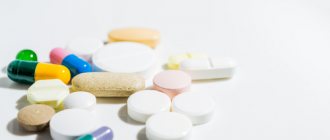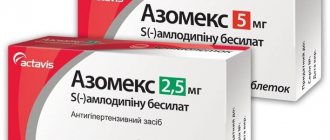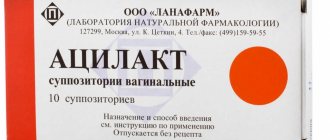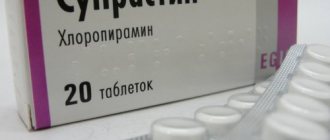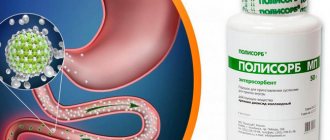Pharmacological properties of the drug Melitor
Agomelatine (N[2-(7-methoxy-1-naphthyl) ethyl]acetamide) is used to treat depressive episodes and recurrent depressive disorders. Agomelatine is a melatonergic agonist of MT1 and MT2 receptors and an antagonist of 5-HT2c receptors. Studies examining the binding of agomelatine to receptors have demonstrated that agomelatine does not affect monoamine uptake and has no affinity for α- and β-adrenergic, histaminergic, cholinergic, dopaminergic and benzodiazepine receptors. Agomelatine does not affect the level of extracellular serotonin and increases the release of dopamine and norepinephrine specifically in the frontal cortex. The effectiveness of agomelatine has been proven in experimental studies in various validated models of depression, as well as in models with desynchronization of circadian rhythms and in modeling stress or anxiety. Experimental studies have found that agomelatine resynchronizes circadian rhythms. Agomelatine preserves sleep structure in healthy volunteers and normalizes sleep in patients with depression. In therapeutic doses, agomelatine does not impair attention and memory in healthy volunteers during the day (based on tests using a visual analogue scale and the ARCI questionnaire). When abruptly stopping treatment with agomelatine, no withdrawal syndrome is observed (based on the results of a study of patients with depression using the DESS questionnaire.) The use of agomelatine does not affect body weight (based on the results of clinical studies). The effectiveness and safety of agomelatine was proven in clinical studies involving 4600 patients with depressive episodes and recurrent depressive disorders, 2400 of whom took agomelatine. Short-term placebo-controlled studies that lasted 6-8 weeks showed statistically significant benefits of agomelatine compared to placebo (the result was assessed by the Hamilton scale (HAM-D17), total score, including symptoms of depression and sleep disturbance). The therapeutic effect (improvement of condition) was noted within 2 weeks after the start of treatment. Similar results were also found in patients with major depressive episodes (pre-treatment Hamilton Depression Severity Scale (HAM-D) ≥25). These studies reported a high percentage of patients who responded to treatment (49.1–61.5%) compared with placebo (34.3–46.3%). Several long-term (>24 weeks) comparative and active control studies have demonstrated the effectiveness of agomelatine in the treatment of patients with depressive episodes and recurrent depressive disorders with long-term use (as assessed by the Hamilton scale (HAM-D17)). Agomelatine has proven effective in treating depression in patients with high initial levels of anxiety. A special comparative study demonstrated that the likelihood of developing new cases of sexual dysfunction when taking agomelatine is lower than when treating with other antidepressants (assessment results on the SEXFX scale). A pooled analysis of ASEX studies demonstrated that agomelatine use was not associated with sexual dysfunction. In patients with depression, agomelatine significantly improved the process of falling asleep and the quality of sleep without daytime sleepiness (as measured by the LEEDS sleep quality questionnaire) from the second week of treatment. Agomelatine is rapidly and well absorbed (≥80%) after oral administration. The maximum concentration in blood plasma is achieved within 1–2 hours after taking agomelatine. Absolute bioavailability is about 3% of the therapeutic dose (individual fluctuations are possible). When agomelatine is used in recommended therapeutic doses, its concentration in the blood plasma increases in proportion to the dose. With a further increase in dose, a saturation effect of the primary passage is observed. Food intake (with a balanced diet or a high-fat diet) does not affect the bioavailability or rate of absorption of agomelatine. Plasma protein binding is 95% regardless of the concentration of the active substance; this figure does not change with age and in patients with impaired renal function. After administration, agomelatine is rapidly metabolized, mainly by the liver enzymes CYP 1A2 (90%), a small amount is metabolized by the isoenzymes CYP 2C9 and CYP 2C19 (10%). The main metabolites (in the form of hydroxylated and demethylated agomelatine) do not have pharmacological activity, are quickly conjugated and excreted in the urine. Agomelatine is characterized by rapid elimination from the body. The half-life from blood plasma averages 1–2 hours. Clearance is high (about 1100 ml/min) and is mainly associated with the excretion of metabolites. It is excreted mainly in the urine (80%) in the form of metabolites. The amount of active substance excreted in urine unchanged is insignificant. The pharmacokinetics of agomelatine does not change with prolonged use. The pharmacokinetics of agomelatine do not change in patients with severe renal impairment, so there is no need for dose adjustment. In volunteers with mild to moderate chronic liver failure, agomelatine concentrations increased significantly, so the use of the drug is contraindicated in liver diseases with impaired liver function.
Choosing an antidepressant based on effectiveness and tolerability
Summary
A classification of side effects of antidepressants is presented. Side effects may be toxic or neuronal. Neuronal side effects are divided into “non-therapeutic” (persistent or reversible) and “para-therapeutic” side effects. Seven categories of antidepressant tolerability have been defined. The lowest category VII included clomipramine, imipramine, maprotiline, agomelatine. Category VI includes amitriptyline, V - pipofezin, trazodone, mianserin and mirtazapine, IV - vortioxetine, III - venlafaxine and duloxetine, II - sertraline, paroxetine, citalopram, escitalopram, fluoxetine, fluvoxamine and milnacipran, I - pirlindole and moclobemide. Among the most effective antidepressants (amitriptyline, imipramine, venlafaxine in high daily doses), venlafaxine had the best tolerability category. This drug is the most effective and tolerable antidepressant. Other options for the practical use of classifications are discussed.
Summary
A classification of the side effects of antidepressants is presented. Side effects can be toxic or neuronal. Neuronal side effects are divided into “extratherapeutic” (persistent or reversible), as well as “paratherapeutic”. Seven antidepressant tolerance categories have been identified. The lowest category VII included clomipramine, imipramine, maprotiline, agomelatine. Amitriptyline belongs to the VI category, pipofezin, trazodone, mianserin and mirtazapine to the V category, vortioxetine belongs to the IV category, venlafaxine and duloxetine to the III category, sertraline, paroxetine, citalopram, escitalopram, fluoxetine, fluvoxamine and milnacipran to the II category, and pirlindole and moclobemide to the I category. Among the most effective antidepressants (amitriptyline, imipramine, venlafaxine in high daily doses), venlafaxine was in the best category of tolerance. This drug is the most effective and tolerable antidepressant. Other options for the practical use of classifications are discussed.
The previous article presented a description of the mechanism of action of various antidepressants (tricyclic - TcA, sertonin-modulating - SMA, tetracyclic - CtsA, reversible inhibitors of monoamine oxidase type "A" - OIMAO-A, selective serotonin reuptake inhibitors - SSRIs, selective serotonin and norepinephrine reuptake inhibitors – SNRIs, norepinephrine and selective serotonin – NaSSA, melatonergic – MeA, multimodal – MmA) (Table 1).
Table 1. Antidepressants known in Russia, their effect on neurons and the “formula” of the mechanism of action (1-4).
* - white color - the drug does not affect neurons, dark gray - a pronounced increase in activity, light gray - a moderate increase in activity, ** - in high doses, IOR - neurotransmitter reuptake inhibitors, SVRR - agents affecting regulatory receptors, OIMAO-A are reversible inhibitors of monoamine oxidase type “A”.
All these drugs, to varying degrees, contribute to the activation of serotonin (↑C or ↑c), norepinephrine (↑H or ↑n), dopamine (↑D or ↑d) or melatonin (↑M or ↑m) neurons, the “tone” of which decreases for depression. But the most pronounced effect on the vital activity of neurons is ↑SNd antidepressants: amitriptyline and imipramine (TcA), as well as venlafaxine (SNRI) in high daily doses. It is no coincidence that many experts consider them to be the most effective drugs for treating depression (5).
Of course, the choice of any antidepressant should be related not only to its therapeutic properties (efficacy), but also to side effects (tolerability). The vast majority of authors agree that tolerability is best with SSRIs and worse with TCAs (6–9), with other drugs falling in between (1). This assessment of the tolerability of antidepressants is correct, but is of a generalized nature. To clarify it, you should refer to data on the mechanisms of side effects.
A minority of them are due to the toxic effect of antidepressants on the organs and tissues of patients. These “toxic” side effects are very dangerous (10). For example, while taking some TCAs (clomipramine, imipramine), as well as MeA (agomelaptine), drug-induced hepatitis is observed, which leads to the death of patients (10, 11). Maprotiline also has serious toxic side effects, causing agranulocytosis and leukopenia (12). Fortunately, toxic side effects are very rare and can be detected promptly by test results.
For example, when it was discovered that agomelatine causes severe and drug-induced hepatitis, detailed precautions were added to its instructions (11). They include a biochemical blood test, which is prescribed to all patients (without exception) before prescribing the drug, as well as while taking it. Similar analysis is required in patients receiving clomipramine and imipramine (13,14). However, when prescribing these antidepressants, biochemical analysis is required only for patients with existing liver diseases. Finally, regular general blood tests to detect agranulocytosis and leukopenia are also necessary during maprotiline treatment (12).
Obviously, the need for additional tests can significantly complicate the use of antidepressants. Fortunately, this is only required when using the medications listed. When prescribing other antidepressants, there is no need to resort to additional examinations. However, their tolerability may be impaired due to the drugs' adverse effects on neurons. As a result, “neural” side effects are formed, which, however, do not directly threaten the lives of patients and are easily diagnosed based on their complaints.
Some of the neuronal side effects are due to the effect of the antidepressant on histamine and acetylcholine neurons, which do not reduce their activity in the formation of mental disorders that are indications for the prescription of antidepressants (2,15). Accordingly, such pharmacological properties can be designated as “non-therapeutic” (extra, unrelated to the treatment process) side effects. They only increase the number of neuronal systems that the patient suffers. Most often, “non-medicinal” side effects are persistent. They may occur throughout the course of treatment, particularly when the antidepressant blocks excitatory receptors on histamine and acetylcholine neurons (15).
This mechanism of action, characteristic of neuroleptics rather than antidepressants, leads to a sharp drop in the activity (inhibition) of these nerve cells (↓G and ↓A) (1,2). Moreover, normal histamine and acetylcholine neurons cannot restore their functions, since there are no effective compensatory mechanisms for this. Accordingly, patients develop persistent mental and somatic symptoms, which seriously complicate treatment (Table 2).
Table 2. The main “non-therapeutic” side effects of antidepressants associated with the blockade of excitatory receptors on histamine and acetylcholine neurons (1,2)
Characterized by drowsiness, fatigue, deterioration of memory and attention. There are complaints of dry mouth, disturbances of accommodation and urination, constipation, pain in the eyes due to increased intraocular pressure, heart rhythm disturbances, increased appetite and weight gain.
There is, however, an antidepressant whose “non-medicinal” side effects are not persistent. This drug is vortioxetine. It does not inhibit histamine and acetylcholine neurons (due to blockade of excitatory receptors), but increases their “tone” due to its influence on regulatory receptors (16). On the one hand, this provides vortioxetine with a unique nature of “non-therapeutic” side effects. In particular, when taking this antidepressant, agitation, anger, “unusual” dreams, and insomnia may occur (Table 3).
Table 3. “Non-medicinal” side effects of vortioxetine (16,17).
Characterized by ketoacidosis, somatic complaints of dizziness, itching (including generalized), sweating, hot flashes, nausea, diarrhea, vomiting. On the other hand, these side effects are fundamentally reversible, since neurons have special mechanisms that are aimed at combating excessive activation. To do this, they can, for example, reduce the sensitivity of their regulatory receptors (a mechanism known as autoregulation). Therefore, “non-therapeutic” side effects of vortioxetine often reduce spontaneously in the first two weeks of treatment (16).
Moving now to the rest of the antidepressants, we point out that the vast majority of them do not have any “non-therapeutic” side effects that increase the number of affected neuronal systems (2). Many drugs do not affect histamine and acetylcholine neurons. Moreover, they increase the activity of only those neurons (serotonin, norepinephrine and dopamine) whose “tone” decreases in mental disorders that are indications for the prescription of antidepressants. However, even this feature cannot relieve antidepressants from “neural” side effects. The latter will arise due to the fact that within any affected neuronal system, the activity of only part of the nerve cells decreases, while the functions of the other part are not impaired. Antidepressants both activate “damaged” neurons and create therapeutic effects, and increase the “tone” of normally functioning nerve cells and cause side effects.
At the same time, the tolerability of antidepressants paradoxically turns out to be “hostage” to their therapeutic properties. The more effectively the drug activates the affected neurons, the more it affects similar nerve cells that are still functioning at the proper level. Therefore, it is advisable to designate the side effects under consideration as “paratherapeutic”. They are manifested by restlessness, restlessness, insomnia and anxiety (Table 4).
Table 4. Main “paramedical” side effects of antidepressants (15)
Somatic complaints are represented by sexual dysfunction, disruption of the digestive system and heart rhythm, and fluctuations in blood pressure. As a rule, “paratherapeutic” side effects are reversible. They may resolve on their own in the second or third week of treatment (18). This is due to the already noted above ability of “normal” neurons to quickly adapt to excessive activation, reducing their sensitivity to neurotransmitters (2)2.
The presented data on toxic and neuronal side effects can be used to classify antidepressants into seven tolerability categories, with the seventh being the worst and the first being the best (Table 5).
Table 5. Categories of tolerability of antidepressants, taking into account toxic and neuronal side effects.
Thus, antidepressants from the lowest category VII (clomipramine, imipramine, maprotiline, agomelatine) have toxic side effects that directly threaten the lives of patients. Moreover, when prescribing them, additional examination of patients is required. Problems with tolerability of other antidepressants are due to neuronal side effects. All of them are not fatal, and their identification usually does not require additional examination.
Neuronal side effects are divided into “non-therapeutic” and “para-therapeutic” side effects. The first, as already mentioned above, are associated with “additional” dysfunction of histamine and acetylcholine neurons, which do not reduce their activity in mental disorders that are indications for the prescription of antidepressants. Accordingly, “non-therapeutic” side effects that expand the range of affected neuronal systems determine whether drugs belong to lower tolerability categories (VI, V and IV). In particular, amitriptyline promotes a persistent decrease in the activity of histamine and acetylcholine neurons and is therefore classified as tolerability category VI. “Non-therapeutic” side effects of antidepressants classified as category V are more limited. After all, pipofezin, trazodone, mianserin and mirtazapine contribute to a persistent decrease in the activity of only histamine neurons. Vortioxetine is classified into the next higher tolerability category IV. This antidepressant has the ability to increase the activity of histamine and acetylcholine neurons. However, the associated side effects are often reversible.
The highest tolerability categories I – III include antidepressants that act only on serotonin, norepinephrine and dopamine neurons, which suffer in mental disorders that are indications for prescribing drugs. These drugs are characterized by “paratherapeutic” side effects that do not increase the number of affected neuronal systems (Table 5). They arise due to the activation of part of the serotonin, norepinephrine and dopamine neurons, which still maintain normal “tone” (2). At the same time, the severity of “paratherapeutic” side effects depends, first of all, on the ability of the antidepressant to affect serotonin and norepinephrine nerve cells, since they all have a weak effect on dopamine nerve cells (Table 1).
Accordingly, tolerability category III includes antidepressants that simultaneously effectively activate serotonin and norepinephrine neurons. These drugs are venlafaxine and duloxetine (Tables 1 and 5). The first of them, depending on the dose, is a ↑SN- or ↑SNd-antidepressant. As for duloxetine, it has the properties of a ↑CH drug. Category II includes antidepressants that promote pronounced activation of only serotonin or only norepinephrine neurons (Tables 1 and 5). These include all ↑C-antidepressants (sertraline, paroxetine, citalopram, escitalopram, fluoxetine, fluvoxamine), as well as the ↑sND antidepressant – milnacipran. Finally, the highest category I of tolerability is possessed by drugs that are not capable of strongly activating serotonin and norepinephrine neurons (Tables 1 and 5). These are two ↑SND antidepressants - pirlindole and moclobemide.
In conclusion, it should be noted that the presented classification of antidepressants by tolerability does not pretend to be comprehensive. However, it provides clear criteria for assessing the main side effects, which allow different drugs to be compared with each other. This seems to be especially significant in a situation where there are no clear recommendations for taking into account side effects when prescribing antidepressants. For example, a generalized formula is currently used in various publications and instructions. It is recommended that an antidepressant be used “only after a careful assessment of the expected benefits versus risks in patients” (11). But the results of such a “careful assessment” are usually in favor of prescribing the drug.
In particular, about agomelatine they write that if all the requirements of the instructions for prescribing an antidepressant are met, then the risk of developing drug-induced hepatitis becomes minimal (19). At the same time, the unique mechanism of action attributed to agomelatine allows us to state that the benefits of prescribing an antidepressant are much greater than the certain inconveniences that are associated with its hepatotoxicity (19). Meanwhile, the uniqueness of the mechanism of action of agomelatine comes down to the possibility of influencing the neurons of the suprachiasmatic nucleus, the neurotransmitter of which is melatonin. And this effect is not at all required for the treatment of depression, since any antidepressant that activates serotonin and norepinephrine neurons can compensate for the deficiency of melatonin activity (20).
The “careful assessment” recommendations presented here are not the only example of facile judgments regarding the tolerability of antidepressants. Some authors believe that side effects are poorly related to the mechanism of action of the drugs. It is argued that side effects are nonspecific, probabilistic and therefore almost unpredictable (18). Other authors are at least looking for the reasons for the formation of side effects in order to take them into account when prescribing antidepressants. Unfortunately, they find these reasons not in the mechanisms of action of the drugs, but in the characteristics of depression, public opinion or the psychology of the patient.
Thus, it is reported that even with the use of any “most easily tolerated drugs in 80% of patients with mild to moderate depression” (21), heterogeneous adverse events are observed. They most often occur in dysthymia, early depressive states, with anxiety and somatic symptoms (21, 22), in people over 45 years of age, with high body weight deficiency (22), and a history of negative placebo reactions (23). It is reported that poor tolerability of antidepressants is associated with patients’ high demands on quality of life (24) and their concerns about social maladjustment (25). An initially negative attitude towards psychiatry on the part of public opinion, the patient’s low awareness of his own illness and the therapy recommended by the doctor, unsatisfactory experience of previous treatment, etc. also contribute to the problem. (22, 26).
The speculative nature of such constructions is obvious. To refute them, it is enough to say that the side effects of drugs, according to the WHO definition, are caused by their pharmacological properties (37). It is difficult to imagine that inhibition of histamine and acetylcholine neurons arises due to the patient’s high demands on quality of life, excessive activation of serotonin, norepinephrine and dopamine neurons due to negative attitudes towards psychiatry from public opinion, and drug-induced hepatitis due to concerns about social maladjustment.
Thus, the presented classification of antidepressants according to tolerability categories allows us to return the study of side effects to the mainstream of biological psychiatry. In addition, this classification is easy to use in practical medicine. In particular, the lower the category of tolerability of an antidepressant, the greater the need for a special justification for its prescription (efficacy, positive experience of treatment in the past, the patient’s desire, etc.). In turn, the appearance of such a detailed justification in the medical history will allow one to avoid many problems (psychological, social and other) that arise during the treatment process between the doctor and his patient.
Using the presented classification, it is easy to resolve the issue of choosing the most effective and tolerable antidepressant. This requires only comparing the tolerability categories of the most effective drugs: amitriptyline (TcA), imipramine (TcA) and venlafaxine (SNRI) (5). The first of them (amitriptyline) belongs to category VI of tolerability (Table 5). The side effects of the second antidepressant (imipramine) are even more serious. This drug belongs to category VII of tolerability. As for venlafaxine, the side effects of this antidepressant are much weaker, and this drug belongs to category III of tolerability. Thus, venlafaxine, when used in high doses, is the most effective and tolerable drug in the treatment of depression.
Venlafaxine is well known in our country under the trade name Velaxin (Egis). This drug has been studied in leading scientific organizations conducting advanced research in the field of psychiatry. Among them are the Federal State Budgetary Institutions “State Scientific Center for Social and Forensic Psychiatry named after V.P. Serbsky" and "Moscow Research Institute of Psychiatry" of the Russian Ministry of Health, St. Petersburg Research Institute named after. V.M. Bekhterev (28,29). Long-acting capsules (Velaxin retard) are also well known (30), with the use of which there is a significant reduction in the frequency of such side effects of the drug as nausea (31). In addition, the study of Velaxin was successfully carried out not only in psychiatry, but also in neurology (32).
A video by M.Yu. Drobizhev on the same topic can be viewed at the link: https://www.youtube.com/watch?v=SwtO_bC_838&t=11s
Bibliography
- Antidepressant therapy and other treatments for depressive disorders. Report of the CINP Working Group based on a review of the evidence. Ed. V.N. Krasnova. M., 2008. – 215 S.
- Stahl SM Stahl's essential psychopharmacology: neuroscientific basis and practical application. — 3rd ed. Cambridge University Press, 2008. - 1117P.
- Drobizhev M. Yu., Fedotova A. V., Kikta S. V., Antokhin E. Yu. Between depression and fibromyalgia: the fate of an antidepressant. Journal of Neurology and Psychiatry. S.S. Korsakov. 2016;116(4): 114-120. DOI:10.17116/jnevro201611641114-120.,
- Shagiakhmetov F.Sh., Anokhin P.K., Shamakina I.Yu. Vortioxetine: mechanisms of multimodality and clinical effectiveness. Social and Clinical Psychiatry 2016;26(4): 84-96
- Bauer M., Pfennig A., Severus E., Wybrau P.S., J. Angst, Müller H.-U. Clinical guidelines of the World Federation of Societies of Biological Psychiatry for biological therapy of unipolar depressive disorders. Part 1: Acute and continued treatment of unipolar depressive disorders as of 2013. Modern Therapy of Mental Disorders 2015;4:33-39.).
- Anderson I.M. SSRIS versus tricyclic antidepressants in depressed inpatients: a meta-analysis of efficacy and tolerability. Depress. Anxiety. 1998;7(Suppl 1):11-17.
- Anderson IM, Nutt DJ, Deakin JF. Evidence based guidelines for treating depressive disorders with antidepressants: a revision of the 1993 British Association for Psychopharmacology guidelines. J Psychopharmacol. 2000;14:3-20.
- Peretti S, Judge R, Hindmarch I. Safety and tolerance considerations: tricyclic antidepressants vs. selective serotonin reuptake inhibitors. Acta Psychiatr. Scand. 2000; Suppl. 403: 17-25.
- Wilson K, Mottram P, Sivanranthan A, Nightingale A. Antidepressant versus placebo for depressed elderly. 2001. Cochrane. Database. Syst. Rev. CD000561.) and worse in TsA
- LiverTox. https://livertox.nlm.nih.gov
- Valdoxan - instructions for medical use of the drug. https://medi.ru/instrukciya/valdoksan_5084/
- Ludiomil - official instructions for use. https://medi.ru/instrukciya/lyudiomil_9448/
- Anafranil tablets - instructions (information for specialists) on the use of the drug. https://medi.ru/instrukciya/anafranil-tabletki_8616/
- Melipramine tablets - official instructions for use. https://medi.ru/instrukciya/melipramin-tabletki_4780/
- Drobizhev M.Yu., Ovchinnikov A.A., Kikta S.V. Why do antidepressants have side effects? Pharmateka. 2015. No. 20 (313). pp. 72-77.
- Brintellix. https://www.rlsnet.ru/tn_index_id_87791.htm
- Subeesh V, Singh H, Maheswari E, Beulah E. Novel adverse events of vortioxetine: A disproportionality analysis in USFDA adverse event reporting system database. Asian J Psychiatr. 2017 Dec;30:152-156. doi: 10.1016/j.ajp.2017.09.005.
- Borodin V.I. Tolerability of treatment in patients with depressive disorders (comprehensive analysis). Author's abstract. for the job application ... doc. honey. Sci. Moscow. 2009.
- Freiesleben SD, Furczyk KJ A systematic review of agomelatine-induced liver injury. Mol Psychiatry. 2015 Apr 21;3(1):4. doi:10.1186/s40303-015-0011-7. eCollection 2015.
- Drobizhev M.Yu. Time of meta-analyses and the effectiveness of antidepressants in depression. Social and clinical psychiatry. 2017;4:81-88.
- Aldushin A.A. Prediction of tolerability and refusal of antidepressant therapy based on the analysis of nocebo effects. Russian Psychiatric Journal. 2009; 3:55-61.
- Avedisova A.S., Borodin V.I., Aldushin A.A. Comparison of the effectiveness and tolerability of antidepressants of different groups for mild and moderate depression. Journal of Neurology and Psychiatry. S.S. Korsakov. 2006;11:15-19.
- Lapin I.P. Personality and medicine. Introduction to the psychology of pharmacotherapy. -SPb.: Dean, 2001.-416С.
- Roberis H. Neurotic patients who terminate their own treatment. Br. J. Psychiatry. 1985; 146 (4):443-445.
- Mosolov S.N., editor. A reference guide to psychopharmacology. Psychopharmacological and antiepileptic drugs approved for use in Russia: 2nd ed. BINOM, Moscow, 2004. - 304C.
- Avedisova A.S., Borodin V.I. Noncompliance or refusal of psychopharmacotherapy? Russian Psychiatric Journal. 2006; 1:61-65.
- https://vmede.org/sait/?id=Farmakologija_klin_farm_y4ebnik_kykes_2009&menu=Farmakologija_klin_farm_y4ebnik_kykes_2009&page=7
- Krasnov V.N., Kryukov V.V. Velaxin® (venlafaxine) in modern treatment of depression: results of the first Russian multicenter study of effectiveness and safety. Psychiatry and psychopharmacotherapy. 2007;9 (4), https://www.consilium-medicum.com/magazines/special/psychiatry/article/15426
- Mosolov S.N., Kostyukova E.G., Gorodnichev A.V., Timofeev I.V., Ladyzhensky M.Ya., Serditov O.V. Clinical efficacy and tolerability of venlafaxine (Velaxin) in the treatment of moderate and severe depression. Modern therapy of mental disorders. 2007;3:58-63.
- Avedisova A.S., Zakharova K.V., Kanaeva L.S., Vazagaeva T.I., Aldushin A.A.. Comparative study of the effectiveness and tolerability of Velaxin and long-acting Velaxin. Psychiatry and psychopharmacotherapy. 2009;11(1):36-40.
- Avedisova A.S. Venlafaxine (Velaxin): results of international studies of a third generation antidepressant. Psychiatrist. and psychopharmacoter. 2006; 11 (2): 2-7.
- Mosolov S.N. Clinical use of modern antidepressants. St. Petersburg, 1995.-565С.).
M.Yu. Drobizhev , Doctor of Medical Sciences, Head of the educational department of the Training Center of the Association of Medical and Pharmaceutical Universities of Russia. Contact Information -
E.Yu. Antokhin , Candidate of Medical Sciences, Associate Professor, Head of the Department of Clinical Psychology and Psychotherapy of the Orenburg State Medical University of the Russian Ministry of Health.
R.I. Palaeva is an assistant at the Department of Clinical Psychology and Psychotherapy at the Orenburg State Medical University of the Russian Ministry of Health.
S. V. Kikta , Candidate of Medical Sciences, Head. Department of the Federal State Budgetary Institution "Polyclinic No. 3" of the Administration of the President of the Russian Federation, Moscow
1 There are probably side effects due to excessive activation of melatonin nerve cells. However, they are not yet described even in the instructions for agomelatine, a melatonergic drug that has a direct effect on them (11).
2 Theoretically, “para-therapeutic” side effects can be observed even against the background of “non-therapeutic” side effects. After all, any antidepressant activates serotonin, norepinephrine or dopamine neurons to varying degrees. However, the drugs are dominated by “non-therapeutic” side effects, if only because they are most often persistent. At the same time, “paratherapeutic” side effects are always reversible. In addition, not all antidepressants that have “non-therapeutic” side effects are capable of seriously activating serotonin, norepinephrine and dopamine neurons.
Use of the drug Melitor
Take orally, regardless of meals or during meals. The tablets should be swallowed whole with water. The recommended dose for adults is 25 mg (1 tablet) 1 time per day before bedtime. After 2 weeks, if necessary, the dose can be increased to 50 mg (2 tablets) 1 time per day before bedtime. According to WHO recommendations, treatment for depression should be continued for at least 6 months after the end of a depressive episode or recurrent depressive disorder (normalization of the condition). Discontinuation of treatment with agomelatine does not require gradual dose reduction. With sudden cessation of treatment with agomelatine, no withdrawal syndrome is observed.
Directions for use and dosage
The recommended dose of Melitor is one tablet (25 mg), which should be taken once before bedtime. Eating does not affect the effectiveness of the medicine.
After assessing the effectiveness of the therapy, after two weeks the dose can be doubled if necessary - up to 2 tablets, which are also taken before bedtime.
Liver function monitoring should be carried out:
- At the beginning of treatment;
- After six weeks (at the end of the acute phase);
- At the end of 12 and 24 weeks (at the end of the maintenance phase);
- Until the end of the treatment course - according to clinical indications.
Typically, treatment for depression is quite long and lasts at least six months. After complete disappearance of symptoms, the medication can be discontinued without gradually reducing the dosage.
Side effects of the drug Melitor
In clinical studies of agomelatine, which included 2400 patients with depressive episodes or recurrent depressive disorders, it was found that side effects were usually mild or moderate and were observed during the first 2 weeks of treatment. The most common side effects were nausea and dizziness. These side effects were usually temporary and, as a rule, did not require cessation of treatment. Side effects observed in short-term placebo-controlled clinical studies, the association of which with agomelatine in doses of 25 or 50 mg has been established or possible, are listed below by frequency of occurrence: very often (1/10); often (1/100 and ≤1/10); uncommon (1/1000 and ≤1/100); rare (1/10,000 and ≤1/1000); very rare (≤1/10,000). From the gastrointestinal tract often: nausea, dry mouth, diarrhea, pain in the epigastric region. From the nervous system: often: dizziness, increased fatigue, drowsiness, migraine; uncommon: paresthesia. Mental disorders often: anxiety; uncommon: sleep disturbances, irritability. On the part of the organ of vision: uncommon: blurred vision. From the skin and subcutaneous fat often: itching, increased sweating; uncommon: dermatitis, eczema, erythematous rash. From the laboratory test indicators: there were several cases (in 0.6% of patients) of increased activity of AST and ALT (3 times higher than the upper limit of normal) when using agomelatine at a dose of 25 or 50 mg.
Special instructions for the use of Melitor
Patients with depression should be under medical supervision, especially at the beginning of treatment. As with other antidepressants, agomelatine should be used with caution in patients with a history of mania or hypomania. If the patient develops manic symptoms, agomelatine should be discontinued. There is no association between agomelatine use and an increased risk of suicide. The risk of suicide is characteristic of depressive conditions, and it may persist until clinically significant remission is achieved. It is not recommended to prescribe agomelatine to children and adolescents under the age of 18 due to the lack of data regarding the use of the drug in this group of patients. Use with caution in elderly patients (over 65 years of age) due to limited clinical data. The drug contains lactose, so it should not be prescribed to patients with congenital galactose intolerance, Lapp lactase deficiency or glucose-galactose malabsorption. As with the use of other antidepressants, the simultaneous use of agomelatine and alcohol consumption is not recommended. The drug should be prescribed with caution during pregnancy (due to the lack of clinical data). In animal experiments, no direct or indirect negative effect on the course of pregnancy, development of the embryo/fetus, influence on the period of childbirth or postnatal development was established. If agomelatine therapy is necessary, breastfeeding should be stopped. There are no clinical data on the penetration of agomelatine into breast milk. Experimental studies have shown that agomelatine and its metabolites pass into breast milk. The effect of agomelatine on an infant during breastfeeding has not been established. Agomelatine therapy does not affect the ability to drive vehicles or operate potentially dangerous machinery, but patients should be warned to exercise caution when performing such activities during treatment, especially if side effects are present.
Pharmacological action of Melitor
Agomelatine (the active component of the drug) is an agonist of melatonin and serotonin 5-HT2C receptors.
Melitor has an antidepressant effect and has positive phase shift properties, bringing the sleep phase closer by increasing the production of melatonin and lowering body temperature.
Melitor according to the instructions does not affect memory and alertness during the daytime, having a predominant effect on sleep:
- Increased slow-wave sleep;
- The time to fall asleep is reduced.
The medication does not cause changes in body weight, heart rate, blood pressure, or withdrawal symptoms. As a result of research, it has been established that Melitor is also non-addictive and has no potential for abuse.
Interactions of the drug Melitor
Drugs that interact with cytochrome P450 1A2 (CYP1A2) and CYP2C9/19 enzymes may reduce or increase the bioavailability of agomelatine, since agomelatine is predominantly metabolized by the above enzymes (90 and 10%, respectively). Drugs that interact with the above enzymes may decrease or increase the bioavailability of agomelatine. Fluvoxamine is a highly active CYP1A2 inhibitor and a moderate 2C9 inhibitor and therefore significantly inhibits the metabolism of agomelatine, resulting in a significant increase in concentrations. Therefore, the simultaneous use of agomelatine with fluvoxamine and ciprofloxacin is contraindicated. Paroxetine is a moderate CYP1A2 inhibitor. Paroxetine does not affect the pharmacokinetics of agomelatine. Fluconazole is a highly active CYP 2C9 inhibitor. Fluconazole does not affect the pharmacokinetics of agomelatine. Agomelatine does not activate or inhibit isoenzymes of the CYP 450 system, therefore agomelatine does not affect the concentration of drugs that are metabolized by CYP 450. Agomelatine does not affect the concentration in the blood serum of the free fraction of substances with a high degree of binding to plasma proteins and vice versa. There are no pharmacokinetic or pharmacodynamic interactions between agomelatine and lorazepam, as well as lithium preparations. There is no experience with the use of agomelatine concomitantly with electroconvulsive therapy. Animal experiments have shown that agomelatine does not cause seizures, so it is unlikely that the simultaneous use of electroconvulsive therapy and agomelatine would lead to clinically significant complications.
Drug interactions
Melitor should not be co-administered with CYP1A2 inhibitors such as ciprofloxacin and fluvoxamine, since this combination of drugs causes a sharp increase in the inhibitory effect of agomelatine on metabolism.
There was no significant therapeutic effect of Melitor when used simultaneously with drugs with high plasma protein binding, as well as other drugs that are most often prescribed as part of combination therapy for depression - lithium, fluconazole, benzodiazepines, paroxetine or theophylline.
Melitor overdose, symptoms and treatment
No cases of overdose have been reported. During clinical trials of the drug, there were several reports of the use of agomelatine at a dose of up to 300 mg in monotherapy or in combination with other psychotropic drugs at a dose of up to 375 mg. In these cases, no signs or symptoms of overdose were noted. There is no specific antidote. In case of overdose, medical observation of the patient’s condition in a specialized department is recommended, and symptomatic therapy is recommended if indicated.


